Basketball Drills - Transition Offense, Fast-Break Drills
By Dr. James Gels, From the Coach’s Clipboard Basketball Playbook"Helping coaches coach better..."
Here are several drills that can help with your transition offense. First read Transition Offense. Transition offense and the fast break can be broken down into its components when practicing and doing drills.
Rebound and outlet pass
First, to get the break going, you must box-out, get the defensive rebound and the quick outlet pass. Some coaches teach getting the outlet pass to the ball-side wing, while others teach passing the outlet directly to the point guard in the center near the free throw line. Design your drill depending on which method you like.Outlet to Wing Drill
Have two offensive and defensive rebounders near the basket. If you are teaching the outlet pass to the wing, have a guard on each wing (free-throw line extended). The coach shoots the ball up and the rebounders fight for position and get the rebound. If the offense gets the ball, they return it to the coach for another shot.When the defender gets the rebound
(show video),
Repeat this over and over, to both sides. From time to time, have another player, manager or assistant step into the outlet passing lane, so that the rebounder learns to look first for his receiver, before blindly making a bad pass.
Outlet to Center Drill
For the center outlet pass, use this same drill, except instead of the wings, have your point guard in the center above the free throw line. Put a defender on O1 so that he/she has to work hard after the rebound to get open and get the pass.The rebounders, instead of pivoting to the outside wing, are now looking up the middle. Once the point guard gets the ball, he/she pivots and starts the speed dribble up court. After reaching mid-court, the drill is over, and the ball is passed back to the coach.
Filling the Lanes
5 on 5, full court Drill
Start the drill with both teams in a half court situation. The coach shoots (misses) and players fight for position and rebound. If the offense gets the rebound, start the drill over. Once the defense rebounds, they should get the outlet and then fill the three lanes, and run the fast break full court, with the trailer and preventer coming last (see Diagram A).If the defense steals or intercepts a pass, they start their own fast break. If the defense stops the break in the half court (without getting the ball), start the drill over on that end of the floor for the other five players.
Pointers:
1. Make sure the outlet is clean and the pass is not forced.2. Try to get the ball centered, if possible.
3. Make sure the lanes are filled quickly, and make sure each player knows his/her assignment. Some coaches feel that it doesn't matter which player is in which lane, but just fill each lane position as quickly as possible and "go!". In the event that two players run the same sideline - the first player up the court back-screens for the second player and then pops to that wing, while the second player cuts around the screen to the hoop, and then out to the opposite wing.
Other coaches teach that the outlet pass always goes to the point guard (the team's best ball handler) in the center, and the outside lanes, trailer and prevent position are assigned to individual players, so each one knows his role.
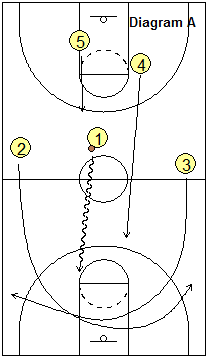
4. The point guard O1 speed dribbles up the middle lane and stops at the free throw line. He/she looks to pass to the wings, or pops the free throw line jumper. If all three lanes are not filled (just two), and O1 has a 2-on-1 situation, he/she can take it to the hoop for the lay-up, or dish off to a teammate.
5. The wings should be looking for the pass from the point, and take it in strong for the lay-up. If the point guard pops the jumper, the wings should rebound. If neither happens, the wings should cross under the basket and fill the opposite corner-wing area.
As they "clear out", the point guard should veer off to the right side of the free throw circle, and the trailer should be coming through for the pass. This all takes timing. If the trailer gets there too soon, the paint will be congested, and if too late, the defense is already in position.
6. If the defense steals the ball during the break, have them push it back up for their own score. Make sure the prevent, safety man is staying back and knows what to do.
Finishing the break
If the point guard has a 2-on-1 situation when attacking the hoop, his/her first thought should be to score or get fouled. He/she attacks the hoop at an angle along the lane line (see diagram below). His/her teammate should be at the opposite low block looking for the pass or rebound. If the defender comes up, or sets to take the charge, pull up and pass to teammate. See this drill.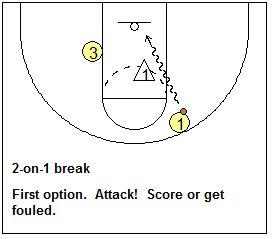
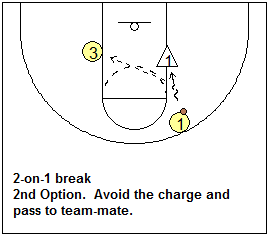
3-on-2 Break
In this situation, there are two defenders back and the offense has the middle and two outside lanes filled. Usually one defender will stop the ball at the top, and one stays inside down low. The point guard should not penetrate beyond the free-throw line or elbow. He/she should look for a wing slashing toward the hoop and pass to the open wing, who then has a 2-on-1 situation with the low defender and should look to score or get fouled as the first option (Diagram A below).Over-passing sometimes results in a turnover, or delays enough to allow other defenders to get back. If the defender sets to take the charge, dish either to the teammate on the opposite block, or back to the point guard for the shot from the elbow (diagram B).
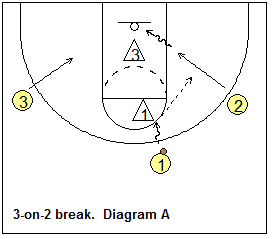
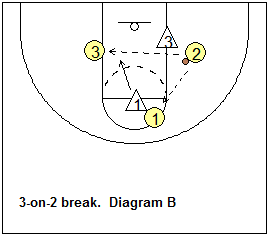
3-on-1, 3-on-2 Drills
Have three lines corresponding to the three lanes of the fast break, at the half-court line. Have your point guards in the middle lane, and your wings on the outside lanes, in the positions where they usually play in a game. Have one defender in the paint.Have your defender who usually plays the "prevent" position as the in-the-paint defender. The point guard runs the 3-on-1 break. Make sure the offense knows their assignments as pointed out above in points 4 and 5. Once they are proficient at breaking the one man defense, have them go 3-on-2.
Related pages:
- Pitch 'n Fire Drill
- Piston Drill
- 4 on 4 Transition
- Rebound-Outlet-Break Drill
- Laker Drill
- War Drill
- 4-on-4-on-4